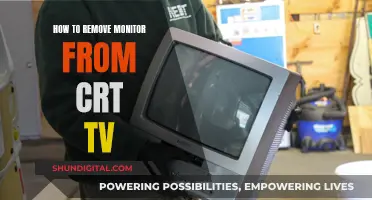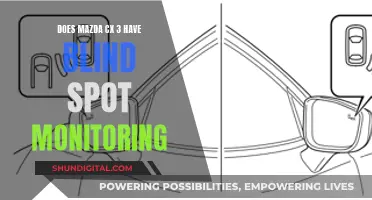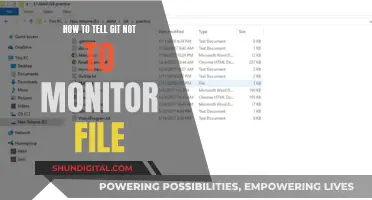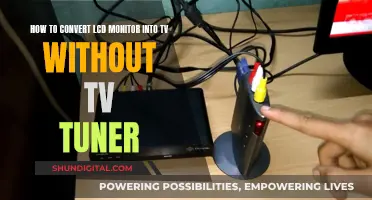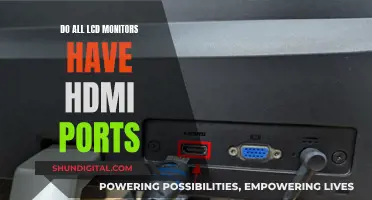
Blind-spot monitoring is a vehicle-based sensor device that detects other vehicles located to the driver's side and rear. While this technology is now common, it was first introduced by Volvo in 2003. Blind Spot Monitoring (BSM) is a key safety feature available in numerous Toyota vehicles, including the 2023 Corolla Cross, the 2017 RAV4 XLE, and the 2016 Lexus LX570. Toyota's BSM uses radar sensors in the rear bumper to detect vehicles in the driver's blind spots and provides visual, audible, vibrating, or tactile warnings. This feature enhances safety during lane changes and manoeuvres, giving drivers added confidence and awareness on the road.
| Characteristics | Values |
|---|---|
| How it works | Uses radar sensors to detect vehicles in the driver's blind spots |
| Warning type | Visual warnings on the side-view mirrors |
| Additional alert | Flashing mirror indicator when the driver activates the turn signal despite the visual warning |
| Activation speed | Available when surrounding vehicles are travelling at speeds above 10 mph |
| Integration with other systems | May integrate with other safety systems, such as the Rear Cross-Traffic Alert (RCTA) system |
| Customizable settings | Can be enabled and disabled through the vehicle's Multi-Information Display (MID) or a dedicated physical button on the dashboard |
| Toyota models with BSM | Corolla, RAV4 XLE, Corolla Cross, Land Cruiser, Lexus LX570 |
What You'll Learn
- Toyota Corolla Cross models from 2023 have blind spot monitoring
- Toyota RAV4 XLE models from 2017 have blind spot monitoring
- Lexus LX570 models from 2016 have blind spot monitoring
- Toyota introduced blind spot monitoring before rear cross-traffic alert
- Blind spot monitoring can be enabled and disabled through the MID

Toyota Corolla Cross models from 2023 have blind spot monitoring
Blind Spot Monitoring (BSM) is a vehicle-based sensor device that detects other vehicles located to the driver's side and rear. Warnings can be visual, audible, vibrating, or tactile. Toyota offers Blind Spot Monitoring on several of its models, including the Corolla Cross.
Toyota Corolla Cross
The 2023 Toyota Corolla Cross comes with the option of adding Blind Spot Monitoring (BSM) with Rear Cross-Traffic Alert (RCTA). This feature is not standard on all models and may require purchasing a package or moving up to a higher trim. For example, the LE Convenience Package includes Blind Spot Monitoring, along with other features such as a smart key proximity key fob, heated side mirrors, and 16-inch alloy wheels.
Other Toyota Models with Blind Spot Monitoring
In addition to the Corolla Cross, Toyota offers Blind Spot Monitoring on various other models, such as:
- Lexus LX570 (since 2016)
- Lexus LC (since 2016)
- Lexus GX 460 (since 2013)
Technical Issues
Some users have reported technical issues with the Blind Spot Monitoring system on their 2023 Toyota Corolla Cross vehicles. Specifically, they have noticed that the Blind Spot Monitors do not work when the car is remote-started using the Toyota app. A potential workaround is to disable and then re-enable the feature, or to restart the car.
Newegg Monitor Buying Guide: Is it Worth the Risk?
You may want to see also

Toyota RAV4 XLE models from 2017 have blind spot monitoring
Blind-spot monitoring (BSM) is a safety feature that uses radar technology to monitor the sides and rear of a vehicle, alerting the driver to any potential hazards that may be lurking in their blind spots. This technology was first introduced by Volvo in 2001 and has since been adopted by many other car manufacturers, including Toyota.
The inclusion of BSM in the 2017 Toyota RAV4 XLE is a significant step forward in terms of safety, especially considering that SUVs tend to have larger blind spots than other vehicles. With this feature, drivers can more easily detect vehicles travelling alongside them in adjacent lanes, as well as traffic approaching from the sides when backing out of a parking space.
It's worth noting that while BSM is standard on the XLE trim, it is not available on all Toyota RAV4 models. For example, the LE Hybrid trim does not come with BSM, and it cannot be added as an option. Similarly, the XLE Premium Hybrid trim excludes BSM, but it can be added as part of an options package.
If you're considering purchasing a new SUV, safety is likely a top priority. The inclusion of BSM in the 2017 Toyota RAV4 XLE model is just one example of how Toyota prioritises safety in its vehicles, ensuring that you can trust your car to help keep you and your family safe on the road.
Best Places to Buy AOC LED Monitors
You may want to see also

Lexus LX570 models from 2016 have blind spot monitoring
Blind Spot Monitoring (BSM) is one of Lexus's latest safety monitoring systems, which uses radar sensors to constantly observe the area in the driver's blind spot for the presence of other vehicles. If the turn indicator is activated, BSM warns the driver by activating an indicator in the door mirror on the appropriate side of the vehicle.
Lexus vehicles equipped with the Lexus Safety System+ come with a Blind Spot Monitor with Rear Cross-Traffic Alert as a standard feature. This system is designed to detect and warn the driver of any vehicles or objects approaching or positioned in the vehicle’s blind spots.
The Blind Spot Monitor system is currently available on Premier grade IS models, as well as the Lexus GS, RX 450h and new Lexus NX luxury crossover.
LCD Monitors: Enhancing Your In-Car Experience
You may want to see also

Toyota introduced blind spot monitoring before rear cross-traffic alert
Blind Spot Monitoring (BSM) is a key safety feature available in numerous Toyota vehicles, designed to assist drivers in detecting vehicles that may be in their blind spots. These blind spots, often located behind the vehicle's C-pillar, can be difficult to spot using just the side and rearview mirrors.
Toyota introduced BSM before rear cross-traffic alert (RCTA). RCTA is a feature that alerts drivers to traffic approaching from the sides when backing out of a parking space. While BSM and RCTA are separate features, they can work together to enhance driver safety.
BSM uses radar sensors mounted in the rear bumper to detect vehicles in the blind spots. When a vehicle is detected, BSM illuminates a warning indicator on the appropriate side-view mirror, alerting the driver to the potential danger. This visual warning can be particularly useful when changing lanes on the highway or navigating through crowded parking lots.
In some Toyota models, BSM and RCTA are integrated, meaning they cannot be individually enabled or disabled. In these cases, a dedicated physical button on the dashboard may be used to control both features simultaneously. However, in most Toyota vehicles, BSM can be easily enabled and disabled through the vehicle's Multi-Information Display (MID).
By introducing BSM before RCTA, Toyota prioritized assisting drivers with lane changes and maneuvering in traffic. BSM provides drivers with an extra set of eyes on the road, enhancing safety and reducing the risk of collisions. This feature demonstrates Toyota's commitment to innovation and driver safety, offering peace of mind to anyone purchasing a Toyota vehicle.
Easy Ways to Check if Your Monitor is 1080p
You may want to see also

Blind spot monitoring can be enabled and disabled through the MID
Blind Spot Monitoring (BSM) is a key safety feature available in numerous Toyota vehicles, designed to assist drivers in detecting vehicles that may be in their blind spots. These blind spots, often located behind the vehicle's C-pillar, can be difficult to spot using just the side and rearview mirrors.
Enabling and disabling BSM is straightforward in most Toyota vehicles. Through the vehicle's Multi-Information Display (MID), drivers can easily access the settings menu and toggle the BSM feature on or off. The MID is typically located in the center of the instrument cluster, and the controls to navigate the menu are on the steering wheel. Once in the Settings menu, look for the option related to BSM settings, which could be listed under a submenu such as "Safety" or "Driver Assistance." From there, you can select the BSM option to access its settings and toggle the feature on or off.
It is worth noting that on some models, BSM and Rear Cross-Traffic Alert (RCTA) are linked and cannot be individually enabled or disabled. In such cases, a dedicated physical button on the dashboard labeled "BSM" or "Blind Spot Monitor" may be used to control the BSM system.
The BSM system uses radar sensors mounted in the rear bumper to detect vehicles in the blind spots. When a vehicle is detected, the system illuminates a warning indicator on the appropriate sideview mirror, providing a visual alert to the driver. This feature is particularly useful when changing lanes on the highway or navigating through crowded parking lots. If the driver activates the turn signal despite the visual warning, the mirror indicator will flash, offering an additional alert.
Toyota vehicles equipped with BSM include the 2017 RAV4 XLE, the 2023 LE AWD Corolla, and the 2016 Lexus LX570.
Is Your Monitor VESA-Compatible? Check with These Easy Steps
You may want to see also
Frequently asked questions
Blind spot monitoring is available in numerous Toyota models, including the 2023 Corolla Cross, the 2017 RAV4 XLE, and the 2016 Lexus LX570.
Blind spot monitoring uses radar sensors to detect vehicles in adjacent lanes. When a car is detected in the blind spot, the system alerts the driver with visual, audible, vibrating, or tactile warnings.
Yes, in most Toyota vehicles, blind spot monitoring can be enabled and disabled through the vehicle's Multi-Information Display (MID) or with a dedicated physical button on the dashboard.
Blind spot monitoring typically functions when surrounding vehicles are traveling at speeds above 10 mph. However, it may not detect stationary vehicles or those moving at very low speeds.
If your blind spot monitoring isn't working, try disabling and then re-enabling the feature. If the issue persists, contact your local Toyota dealer or visit the Toyota website for further assistance.


